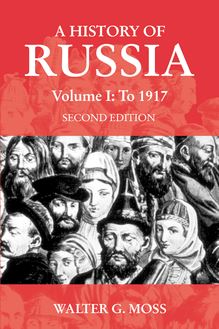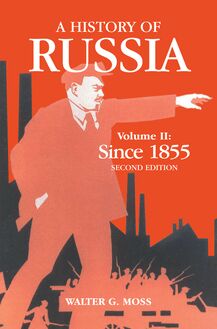A History of Russia Volume 1 , livre ebook
654
pages
English
Ebooks
2003
Obtenez un accès à la bibliothèque pour le consulter en ligne En savoir plus
Découvre YouScribe en t'inscrivant gratuitement
Découvre YouScribe en t'inscrivant gratuitement
654
pages
English
Ebooks
2003
Obtenez un accès à la bibliothèque pour le consulter en ligne En savoir plus
Publié par
Date de parution
01 juillet 2003
Nombre de lectures
1
EAN13
9780857287526
Langue
English
Poids de l'ouvrage
21 Mo
A comprehensive and accessible history of the culture, people and politics of this vast and enigmatic nation.
This new edition retains the features of the first edition that made it a popular choice in universities and colleges throughout the US, Canada and around the world. Moss's accessible history includes full treatment of everyday life, the role of women, rural life, law, religion, literature and art. In addition, it provides many other features that have proven successful with both professors and students, including: a well-organized and clearly written text, references to varying historical perspectives, numerous illustrations and maps that supplement and amplify the text, fully updated bibliographies accompanying each chapter as well as a general bibliography of more comprehensive works, a glossary, and chronological and genealogical lists. Moss's 'A History of Russia' will appeal to academics, students and general readers alike.
List of Maps; Preface to the Second Edition; A Note to Students; Introduction; Part I. The Rus Era; Part II. The Mongols and the Rise of Moscow to 1533; Part III. Muscovy and Its Expansion, 1533-1689; Part IV. Early Imperial Russia, 1689-1855; Part V. Late Imperial Russia, 1855-1917; General Bibliography for Russia to 1917; Appendix A. Chronology; Appendix B: Rus/Russian Thinkers; Appendix C: Glossary; Index
Publié par
Date de parution
01 juillet 2003
Nombre de lectures
1
EAN13
9780857287526
Langue
English
Poids de l'ouvrage
21 Mo
A History of Russia
SECOND EDITION
Volume I: To 1917
Walter G. MossA History of Russia
SECOND EDITION
Volume I: To 1917
Walter G. Moss
Department of History and Philosophy
Eastern Michigan University
Anthem PressAnthem Press
An imprint of Wimbledon Publishing Company
75-76 Blackfriars Road, London SE1 8HA
or
PO Box 9779, London SW19 7ZG
www.anthempress.com
This edition published by Anthem Press 2005
Walter G. Moss © 2005
The moral right of the authors has been asserted.
All rights reserved. Without limiting the rights under copyright reserved above,
no part of this publication may be reproduced, stored or introduced into a retrieval
system, or transmitted, in any form or by any means (electronic, mechanical,
photocopying, recording or otherwise), without the prior written permission of
both the copyright owner and the above publisher of this book
Acknowledgments
Chapter 3, page 34: Thomas S. Noonam, “The Flourishing of Kiev’s
International and Domestic Trade, ca. 1100–ca. 1240.”In I. S. Koropeckyi
(ed.), Ukranian Economic History: Interpretive Essyas (Cambridge,
Massachusetts: Harvard Ukranian Research Institute, 1991). © 1991,
President and Fellows of Harvard College. Reprinted by permission;
Chapter 9, page 150: Jacques Margeret, The Russian Empire and Grand
Duchy of Muscovy: A 17th-Century French Account, trans. And ed. By
Chester S. L. Dunning, © 1983. Reprinted by permission of the University
of Pittsburgh Press; Chapter 14, page 255: Christian Hermann von
Manstein, Contemporary Memoirs of Russia: From the Year 1727 to
1744, No. 7 in Russia through European Eyes. London: Frank Cass &
Co. Ltd., 1968.
Maps by David Lindroth, Inc.
British Library Cataloguing in Publication Data
A catalogue record for this book is available from the British Library.
Library of Congress Cataloging in Publication Data
A catalog record for this book has been requested.
ISBN 1 84331 023 6 (Pbk)
3 5 7 9 10 8 6 4 2To Nancy, with more love and appreciation than everContents
List of Maps xv
Preface to the Second Edition xvii
A Note to Students xxi
1. Land and Peoples: From Ancient Times to the Present 1
The Land: Physical Features, Climate, and Resources 1
Geography’s Impact on Colonization and National Identity 8
The Peoples: From Ancient Times to the Present 9
Suggested Sources 11
PART I
The Rus Era
2. Rus Politics 15
Varangians and the Princes 15
Domestic Politics of Rus 22
Slavic-Varangian Expansion and Foreign Powers 26
Suggested Sources 32
3. Rus Society, Religion, and Culture 34
The Towns 35
Foreign and Domestic Trade 36
Rural Life 37
Class Structure and the Military 38
Women 39
Secular and Church Law 41
Religion and Culture 42
Suggested Sources 52viii Contents
4. The Rise of New Centers 54
Growing Rus Diversity and the Fate of Kiev 54
Rise of Suzdalia 57
Significance of Suzdalia 59
Galicia and Volhynia 60
Novgorod 61
Conclusion 63
Suggested Sources 64
PART II
The Mongols and the Rise of Moscow to 1533
5. The Mongol Conquest and Subjugation 67
The Mongol Empire and the Invasion of Rus 67
Mongol Rule in the Thirteenth Century 69
Mongol Rule and Russian Princes: Suzdalia and Novgorod 73
Mongols and Russian Historiography 76
Suggested Sources 77
6. Moscow and Its Rivals, 1304–1533 79
Emergence of Moscow, 1304–1389 79
The Lithuanian Challenge 83
Moscow’s Struggles and Successes, 1389–1462 85
The End of Novgorodian Independence and the Triumph of Moscow,
1462–1533 88
Evolution of Muscovy’s Government 94
Causes of Moscow’s Success 97
Suggested Sources 99
7. Society, Religion, and Culture, 1240–1533 101
Mongols’ Economic Impact 101
Eating and Drinking; Famines and Other Calamities 105
Rural Life and the Military 107
Class Structure and Slavery 108
Women and Family Life 110
Growth of the Law 112
Religion 113
Literature and Art 116
Suggested Sources 123Contents ix
PART III
Muscovy and Its Expansion, 1533–1689
8. Ivan the Terrible: Autocrat 129
Ivan IV: Sources and Personality 129
Childhood, Coronation, and Early Domestic Policies 130
Muscovy Expansion: Successes and Failures 132
Domestic Policies, 1558–1584 137
The Legacy of Ivan IV 141
Suggested Sources 143
9. The Time of Troubles, 1598–1613 146
Background: Russia under Fedor (1584–1598) 146
Tsar Boris, Civil War, and Pseudo Dmitri 147
Tsar Vasili Shuisky and Renewed Civil War 151
Foreign Intervention, Continued Civil War, and the
Selection of Mikhail Romanov 155
Conclusion 157
Suggested Sources 158
10. The First Romanovs, 1613–1689 160
The Reign of Mikhail, 1613–1645 160
The Reign of Alexei, 1645–1676 162
Fedor III and Sophia, 1676–1689 170
Government and Administration, 1613–1689 173
The Continuing Development of Autocracy 175
Conquest of Siberia 178
Suggested Sources 181
11. Economic and Social Life, 1533–1689 184
Economic, Overview, Population, Urban Life, Manufacturing,
and Trade 185
Drinking, Smoking, Fires, Famines, and Plagues 189
Peasants and the Establishment of Serfdom 191
Service State, Social Structure, and Slavery 192
The Military 195
Women and Family Life 196
Crimes, Punishments, and the Law 198
Suggested Sources 202
12. Religion and Culture, 1533–1689 205
Religion 206
Popular Culture 211
Learning, Morality, and Literature 213
Architecture and Painting 217
Suggested Sources 220x Contents
PART IV
Early Imperial Russia, 1689–1855
13. Peter the Great 226
Youth and Personality 226
The Ousting of Sophia and the First Decade of Peter’s Reign,
1689–1699 228
The Great Northern War and Foreign Affairs, 1700–1725 231
Domestic Changes and Reforms 234
Opposition 244
Peter’s Death and Legacy 247
Suggested Sources 249
14. Three Empresses and Three Emperors: Rulers and
Politics, 1725–1762 251
Catherine I and Peter II, 1725–1730 252
Anna, the Nobles, and the Crisis of 1730 253
The Reign of Anna, 1730–1740 255
Ivan VI and Elizabeth, 1740–1761 256
Diplomacy and Wars, 1725–1761 258
The Short Reign of Peter III 260
The Empire, 1725–1761 262
Suggested Sources 265
15. The Reign of Catherine the Great 267
Catherine II: Background and the 1762 Coup 268
Domestic Policies 269
Political Opposition and Criticism 275
Foreign Policy 280
The Empire: Uniformity, Integration, and Colonization 285
Catherine’s Death and Significance 288
Suggested Sources 288
16. Eighteenth-Century Economic and Social Life 291
Population and Towns 291
Manufacturing and Trade 293
Villages and Housing 295
Agriculture, Nobles, and Peasants 297
Eating and Drinking; Famines and Other Calamities 301
Women and Family Life 305
Russian Law: Change and Continuity 308
Suggested Sources 311Contents xi
17. Eighteenth-Century Religion and Culture 313
Russian Orthodoxy 313
Schismatics and Sectarians 315
Philosophy, Freemasonry, and Public Life 316
Education and Scholarship 318
Language and Literature 320
Art and Music 324
The Problem of Two Cultures 327
Suggested Sources 328
18. The Reigns of Paul and Alexander I, 1796–1825 331
Emperor Paul and His Domestic Policies 331
Alexander I and Reform, 1801–1812 334
Russian Foreign Policy, 1796–1812 338
Napoleon and Russia, 1812–1815 341eign Policy, 1815–1825 343
Ruling the Empire, 1796–1825 344
Domestic Policies, 1815–1825 348
Political Opposition and the Decembrists 349
Suggested Sources 354
19. Nicholas I: Despotism, Reform, and Legitimacy,
1825–1855 356
Nicholas I: The Man and His Political Views 357
Administration and Internal Policies 358
Nicholas and the Western Nationalities 361
Public Opinion and Opposition 364
Foreign Affairs and Russian Expansion 368
The Military and the Crimean War 371
Suggested Sources 374
20. Economic and Social Life, 1796–1855 376
Population and Towns 376
Industry and Trade 379
Nobles and Peasants 382
Eating and Drinking; Famines and Diseases 389
Women and Family Life 391
Laws, Courts and Punishment 395
Suggested Sources 397
21. Religion and Culture, 1796–1855 400
Religion 400
Education and Scholarship 405
Literature 409
Art and Music 414
Suggested Sources 417xii Contents
PART V
Late Imperial Russia, 1855–1917
22. Alexander II, Reformism, and Radicalism 422
Alexander II: The Man and His Times 422
Emancipation of the Serfs 424
Additional Reforms 427
Autocracy and Its Opponents 431
Suggested Sources 438
23. Reactionary Politics, Economic Modernization, and
Political Opposition, 1881–1905 441
Alexander III and Pobedonostsev: The Autocrat and His Chief Adviser 441
Reactionary Policies of Alexander III 443
Policies of Economic Modernization, 1881–1903 446
Nicholas II and the Politics of Reaction, 1894–1904 449
Public Opinion and Political Opposition, 1881–1904 453
Suggested

